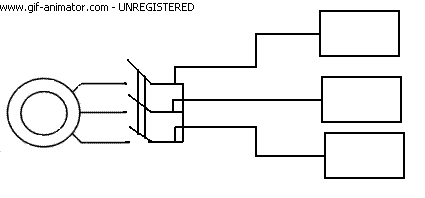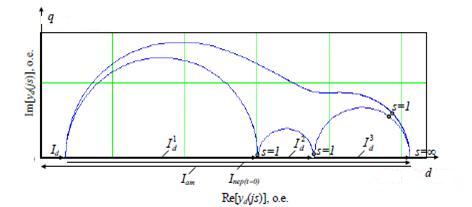Abstract
Сontent
Introduction
For reliable operation of synchronous machines, i.e., generators, motors and сcompensators we need to know their correct equivalent schemes and parameters of these schemes. This allows us to define the behavior of the machine under various disturbances of short-circuits, load-ons and load-sheddings, over-voltages.
The procedure of the experiment sudden three-phase short-circuit is regulated by a number of documents: recommendations of the International Electrotechnical Commission IEC 34-4 [1], the U.S. standard IEEE 115 and operating in Ukraine and CIS countries the industry standard GOST 10169-77 "Three-phase synchronous electric machines. Methods of testing" [2]. Production experience shows that when using the standard method of GOST there is a significant variation of parameters even for automated reading of current curves from machine terminals and processing of the experimental data with the help of computers. These errors manifest themselves in the form of the spread of the calculated quantities and make it difficult to answer the question: is it a theoretical incorrect assumption in the development of computational algorithms, or is unable to register in the experiments required mode settings with a given accuracy. There are many papers about the improving of accuracy of the experimental determination of the synchronous machines parameters by the short-circuit test [6], [7], [10].
1. Short-circuit test and evaluation of test data
For the experiments a sudden three-phase short-circuit current must follow a number of conditions:
1. The machine rotates at no-load mode.
2. The machine rotates at synchronous speed of rotation.
3. The exciter is operating normally.
4. Automatic field weakening is switch-off.
5. three-phase switch in the open position is connected to the terminals of the machine, three-phase short-circuit is set on the other side of a switch.
6. The shunt machines are connected to the terminals electronic recorders signals.
Then, at an arbitrary time they closes switch, recorded currents in each phase, and begins the next stage - the processing of the experimental data.

Figure 1 - Process of short-circuit test performing
Animation (number of frames:5, number of cycles:5, size: 18,6 кБ)
To better define the parameters of machines to use the refined mathematical model, which is presented below. This formula describes the instantaneous value of the current in phase A stator winding at short-circuit from the no-load mode. Similar expressions are obtained for the other two phases [10]:
At processing the measurement results must be considered an infinite number of circuits in the rotor damper machine that does not provide the method of GOST. Depending on the type of synchronous motor, the desired accuracy, the devices used in the calculation we take necessary and sufficient number of circuits.
The loci of the individual circuits are equivalent rotary circle whose diameter is determined by the initial values of the corresponding exponential components, approximating periodic stator current. See figure 2.

Figure 2 - Complex conductivities of equivalent rotor circuits
As we can see from the figure 2 the standard method involves the determination of subtransient inductance as resistance machines like the part of the stator winding from an infinite sliding of rotor. This corresponds the fact that the initial value of the periodic component of the short-circuit current determines the conductivity of the synchronous machine when sliding is infinity. In fact, these values must be determined at sliding s = -1 [10].
In addition, the standard method assumes that the periodic and aperiodic components are, respectively, as half the difference and half the sum of the phase currents curves [6], [7]. Approximation of periodic current carried by sequentially allocating first transition (according to the final stage of the process), and then subtransient (at the initial part of the transition function is found after subtraction transition) components. Analysis of the parameters of multiple-equivalent circuits of some industrial turbine generators, indicates the presence of the rotor circuits, electromagnetic time constants are less than half-synchronous speed. Hence the need for a greater sampling of experimental data that can be successfully done with the help of modern digital recorders electric mode settings, and using the vector representing the stator current transient synchronous machine. In this case, will be considered exponential with time constants commensurate with the time half-power frequency to.
According to the calculation of sort-circuit from the no-load mode law of the stator current vector change can be written as follows [10]:
Conclusion
The new approach reduces the error in determining the frequency characteristics by eliminating systematic error inherent in the standard method. A new approach to the experimental determination of the frequency characteristics of the conductivity of the stator winding is proposed, based on the analytical description of the changes in the generalized vector of the stator current for three-phase short circuit at the terminals of synchronous machines, which allows to improve a standard method, recommended by GOST 10169-77.
This master's work is not completed yet. Final completion: December 2013. The full text of the work and materials on the topic can be obtained from the author or his head after this date.
References
- International Electrotechnical Commission (IEC) Standard. Rotating Electrical Machines. Part 4: Methods for determining synchronous machines quantities from tests. Publication 34-4. Geneva, 1985. – 175 p.
- Машины электрические синхронные трехфазные. Методы испытаний: ГОСТ 10169-77. – М.: Изд-во стандартов, 1984. – 78 с.
- Kamwa I. Phenomenological models of large synchronous machine from short-circuit test during comissioning - A clasical / modern approach / I. Kamwa, P. Viarouge, R. Machfoudi // IEEE Tranc. on Energy Conversion, 1994, V.9, № 1 – P. 85-97.
- Kamwa I. Computer software to automatic graphical analysis of sudden - short - circuit oscillograms of large synchronous machines / I. Kamwa, P. Viarouge, M. Pilote, et al. // IEEE Tranc. on Energy Conversion, 1995, V.10, № 3. – P. 399-406.
- Kamwa I. Experience with computer -aided graphical analysis of sudden - short - circuit oscillograms of large synchronous machines. / I. Kamwa, P. Viarouge // IEEE Tranc. on Energy Conversion, 1995, V.10, № 3. – P. 407-414.
- Харченко В.А. О разбросе значений параметров синхронных машин, находимых из опыта внезапного короткого замыкания / В.А. Харченко // Изв. РАН. Энергетика. – 1996. - № 2. – С. 127-137.
- Харченко В.А. Еще раз о разбросе значений параметров синхронных машин, находимых из опыта внезапного короткого замыкания / В.А. Харченко // Изв. РАН. Энергетика. – 1999. - № 1. – С. 142-151.
- Казовский Е.Я. Переходные процессы в электрических машинах переменного тока / Е.Я. Казовский. – М.: Изд-во АН СССР, 1962. – 624 с.
- Грановский В.А. Автоматизация измерений и вопросы методологии измерений / В.А. Грановский, С.Г. Рабинович / В.А. Грановский // Методы и средства автоматизации научного эксперимента. – М.: ЦНИИТТЭИ приборостроения, 1972
- Ларин А.М., Шеина А.А. Новый подход к определению частотных характеристик синхронных машин по данным опытов внезапного трехфазного короткого замыкания // Наукові праці Донецького національного технічного університету № 10(180), 2011
